The app economy is expected to reach over $100 billion in global revenue by the year 2020. Despite this astronomical revenue, failing to monetize is one of the most common reasons why app publishers abandon the app market altogether. In fact, a study from Clear Bridge Mobile found that more than half of mobile app developers generated little to no revenue from their mobile apps in 2017.
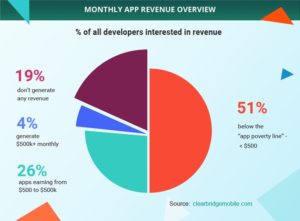
App publishers know that the best way to make money from their apps is to sell ad space. However, most app users find any type of advertisement that interrupts their user of an app to be annoying and disruptive. In today’s ad-heavy world in which an individual will see thousands of ads every day, users have grown to hate constant bombardment from advertisements and will often abandon a mobile app altogether if they feel they’re exposed to too many ads. How can app publishers and owners monetize their mobile apps without sacrificing the user’s experience and scaring off users?
Advertising and The User Experience
The User’s in-app experience is critical to the success of the mobile app, and UX plays a critical role in branding and positive brand sentiment. An app user wants to use an app without being interrupted in any way, which means any type of advertising that disrupts this experience can turn the user away from the app. Many traditional in-app advertising options, including pop-ups, banners, or certain types of ads, can cause a poor user experience if implemented incorrectly or without consideration for the user. Consumer favorability varies by ad type, with more than 70% of those surveyed finding “Online Pop-Up Ads” to be an unfavorable addition to their app experience.
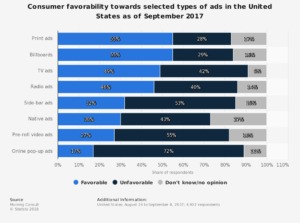
What’s more, the consequences of a poor mobile experience due to ads can be extremely costly. 48% of users who had a bad mobile experience say that they are less likely to use the mobile app, and 34% said they would consider switching to a competitor’s app if they felt the competitor’s app would offer a better UX. A strong user experience not only increases app revenue and brand reputation, but it also results in higher user retention rates and higher Customer Lifetime Value of app users.
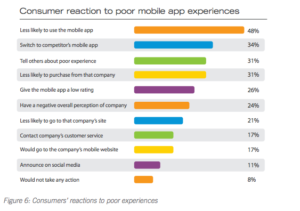
When implemented correctly, in-app ads can be successful in monetizing mobile apps without sacrificing a strong user experience. While there are a wide variety of ad types available on the web, there are a few in-app ad types that are most commonly used to monetize mobile apps. Understanding the different types of in-app advertisements can help you determine which type will be the least disruptive to your user’s app experience and least likely to have negative effects on your mobile users.
Types of In-App Ads
If you do decide to monetize your mobile app through in-app advertisements, choosing the right ad type and monetization strategy is key to your app’s success. In-App ad types include:
Interstitial Ads
Interstitial ads are ads that generally cover the full interface of the device. This full-screen pop-up grabs the user’s attention and forces them to look at the ad and take an action if they want to click into the ad or continue to use the app. Interstitial ads are excellent for CPM-based advertising goals.
Banner Ads
Banner ads occupy a small amount of space on a user’s device within the app and generally stay on the screen while the user interacts with the ad. Banner ads frequently fall victim to “ad blindness”, which occurs when users stop paying attention to ads altogether. Banner ad engagement rates are fairly low, around 0.58%.
Video Ads
Video ads are ads that play before, during, or after a video on the web. These ads can range in length from 5 seconds to 120+ seconds. Video advertising generally performs well compared to other in-app ad types.
Playable Ads
Playable ads are mobile advertisements that allow a player to experience part of a game immediately. This ad type allows a user to play a mini-game within another app, and earn a reward of some sort in exchange for playing the game. In 2017, 45% of app marketers were excited and interested in the engagement that playable ads would bring to their mobile apps.
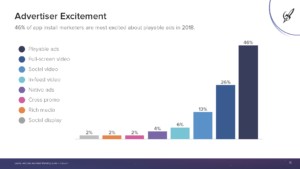
Many game app partners have already implemented playable, “reward” ads into their mobile apps to help the monetize. Playable apps get the user excited to play a game and engage with the ad. This ad type adds to the user’s experience within the app, rather than disrupting it.
Native Ads
Native ads are ads that provide an integrated ad experience that blurs the line between the app’s design and an advertisement. Native ads in apps often have similar designs and layouts to the app itself. Native ads have a comparatively strong User Experience since the ads appear to be an intentional component of the app.
Each of these ad types provides a unique benefit to advertisers, but even the most targeted mobile ads can be disruptive to the user’s experience if the ads are not implemented with UX in mind.
Monetizing without Ads
Believe it or not, there are ways for mobile app publishers to monetize their apps without showing ads to their users.
Paid Download
Charging your users to download your app is the most cut-and-dry monetization method, but this method continues to become more and more unpopular and can cause lower download rates. In 2013, over 75% of app revenue was generated through paid downloads. In 2017, this figure decreased to 37%.
While users are less likely to download an app that costs money up front to download, users will pay to download an app if they feel that it gives them a value that is truly worth the investment. If you’re an app developer or publisher whose app is unique and offers a unique value that other apps don’t offer, the paid download strategy can result in loyal, paying customers that are willing to make an investment in your product. Additionally, apps in niche industries like health and wellness, fitness, and productivity are more likely to have high download rates despite their upfront charge.
By providing unique, innovative benefits and options that free apps can’t or don’t currently offer, App Publishers can successfully implement a paid download monetization strategy that does not sacrifice the user’s experience with disruptive ads.
Go Freemium
The freemium model allows the user to download and use the basic functions of a mobile app for free and pay for access to gated premium features and capabilities. This model allows app developers and publishers to attract a large number of users to their free app(s), and allows users to try out an app before they commit to making a purchase.
With a freemium model, users who are unfamiliar with your app can try it out and easily upgrade to premium features. This low-risk situation makes a user more likely to download the app rather than turn to a competitor. The freemium monetization model works best for games, educational apps, and apps that offer advanced functionality and data visualization. The average conversion rate for freemium model apps remains comparatively low, less than 1%.
Show Ads At The Right Moment
If you decide to display advertisements as a part of your app monetization strategy, the timing of your ads can be critical to the UX of your app. By anticipating your app user’s behaviors and needs, you can better serve them with advertisements that add value to their experience in your app. Showing the right ad(s) at exactly the right moment with a service like Appnext Actions encourages your user to find your app helpful and worthwhile, rather than disruptive and annoying.
In-App Purchases
In-App Purchases involve the ‘sale’ of virtual goods or services to be used within an app. In-app purchases are similar to the freemium model in that they allow the user to experience the basic functions of the mobile app but require a purchase to unlock premium features, credits, or access levels.
Extremely popular with game apps, in-app purchase models work best with free apps. Many games allow users to earn a small number of credits through app use, or give users the option to simply buy credits to continue to use the app or the app’s advanced features. This type of monetization strategy does not interrupt the user’s experience and encourages your app user’s to make a purchase if they want to continue to get value from your app.
Sponsorship
Sponsorship involved a partnership with other brands and advertisers and requires users to complete certain in-app actions. Generally, sponsors are other brands in similar niches and industries that want to encourage your app’s users to also engage with their brands as well. Apps with a robust user base will have the most success in implementing Sponsorship as a method of monetization. Additionally, the sponsorship-based monetization strategy provides the added benefit of encouragement for the user to continue to use your app.
RunKeeper is an excellent example of monetizing apps through sponsorship. RunKeeper users get exclusive rewards from health and fitness brands if they complete pre-determined in-app actions. This keeps users engaged with the RunKeeper app while also monetizing the app experience.
Source:https://www.jaybirdsport.com/blog/jaybird-and-runkeeper-team-up/
Subscription-Based “Paywalls”
While Freemium models encourage users to try an app before they commit to buying it, subscriptions require users to sign up for a subscription to gain full access to app features or bypass content restrictions and limits. Users can interact with some or all of the features of the app for a limited time, and will then be required to purchase a subscription to the app.
Subscription-based strategies are best for content-driven apps such as news apps, video streaming or editing apps, premium functionality apps, or apps that contain tiered levels of access to app features. By offering a variety of subscription levels, your users can choose the subscription level (and cost) that works for them. This type of monetization usually does not negatively affect the user’s experience within the app and encourages users to pay to gain access each month.
Subscription-based models can be difficult to maintain, however. Since most subscription-based strategies implement a monthly billing cycle, app publishers must provide value each billing cycle or users will likely not continue their subscriptions.
Smart Personalization
Advanced segmentation and targeting can be extremely beneficial in ensuring your user’s in-app experience is not negatively affected by ads. Timely push notifications boast some of the highest engagement rates in the industry, with well-placed, well-timed push notifications reaching up to 40% engagement.
Publishers must be smart about the types of content and timing of notifications they push out to their audiences. Sending out too many notifications or untargeted, irrelevant notifications will encourage the user to ignore or even turn off future notifications. Additionally, push notifications that add value and are based on a user’s previous habits or preferences have a much higher chance of success and add to, rather than take away from, a user’s in-app experience.
There are many methods of monetizing a mobile app, not all of which include disruptive ads that scare your users off. By keeping the User Experience as the top priority, app publishers can monetize their apps without sacrificing quality.
.


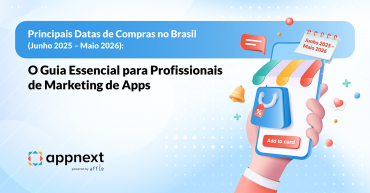
Comments are closed.